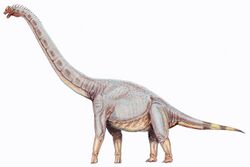Biology:Sonorasaurus
| Sonorasaurus | |
|---|---|

| |
| Scientific classification | |
| Domain: | Eukaryota |
| Kingdom: | Animalia |
| Phylum: | Chordata |
| Clade: | Dinosauria |
| Clade: | Saurischia |
| Clade: | †Sauropodomorpha |
| Clade: | †Sauropoda |
| Clade: | †Macronaria |
| Family: | †Brachiosauridae |
| Genus: | †Sonorasaurus Ratkevich, 1998 |
| Species: | †S. thompsoni
|
| Binomial name | |
| †Sonorasaurus thompsoni Ratkevich, 1998
| |
Sonorasaurus is a genus of brachiosaurid dinosaur from the Early to Late Cretaceous (Albian to Cenomanian stages, around 112 to 93 million years ago). It was a herbivorous sauropod whose fossils have been found in southern Arizona in the United States. Its name, which means "Sonora lizard", comes from the Sonora River that flows in the Sonoran Desert where its fossils were first found. The type species is S. thompsoni, described by Ratkevich in 1998.
Discovery
Fossilized remains were discovered in November 1994 by geology student Richard Thompson in the Turney Ranch Formation, located in the Chihuahua Desert region of the Sonoran Desert in southern Arizona. Thompson had investigated a previously almost unexplored region, where fossils proved to be plentiful and directly accessible on the surface. A relatively complete sauropod skeleton was weathering out on a rock wall. He informed paleontologist Ronald Paul Ratkevich of the Arizona-Sonora Desert Museum, Tucson of the find. Ratkevich assembled a team of volunteers and began securing the bones in the spring of 1995; excavations would only end in 1999. He assumed the fossils represented a sauropod but was no expert on that taxon. The curator of geology of the museum, David W. Thayer, thought it might be a therizinosaur, mistaking a tail chevron bone for the long hand claw typical of that group. In 1995, Ratkevich and Tayer first reported the find, already using the name "Sonorasaurus" but informally, so that it remained a nomen nudum.[1]
Both men now asked dinosaur expert Edwin Harris Colbert to identify the animal. Colbert, having seen only pictures, suggested it might be a member of the Hadrosauridae. Ratkevich and Thayer then visited the displays in the American Museum of Natural History, concluding their find was rather dissimilar to the hadrosaurid skeletons shown there, so that it must represent a species new to science. Ratkevich considered naming it "Chihuahuasaurus" but ultimately shied away from the comical contrast between the gigantic sauropod and the minute dog breed. In 1996, a subsequent article tried to fit the bones found, in a diagram of the hadrosaurid Kritosaurus. This attempt largely failed, with an ilium being mistaken for a shoulder blade. Again, the name "Sonorasaurus" was used but still invalidly.[2]
Sonorasaurus was finally formally described in 1998 by Ratkevich, who identified it as a brachiosaurid sauropod. Dating of the specimen found it to be the earliest known brachiosaurid to have lived in the 'middle' Cretaceous Period of North America.[3] On April 10, 2018, Sonorasaurus was declared the state dinosaur of Arizona.[4]
Description
The holotype of Sonorasaurus, ASDM 500, is an incomplete skeleton consisting of various postcranial elements, many of which are fragmentary. A complete dorsal rib from the same horizon, ASDM 807, may also be referrable to S. thompsoni.[3] Sonorasaurus is estimated to have been about 15 meters (49 feet) long and 8 meters (26 feet) tall, about one third of the size of Brachiosaurus.[3]
Classification
Ratkevich initially identified Sonorasaurus as a brachiosaurid.[3] However phylogenetic studies in the following years failed to find a consensus, with some finding it to lie within Brachiosauridae[5] and others outside of it.[6] In no analysis was the recovered phylogenetic position of Sonorasaurus strongly supported until D'Emic et al. (2016), which found Sonorasaurus to fall confidently within the Brachiosauridae. However the authors noted that additional data was still required to firmly establish its lower-level affinities.[7]
Sonorasaurus in a cladogram of Brachiosauridae after Mannion et al. (2017).[8]
| Brachiosauridae |
| ||||||||||||||||||||||||||||||||||||||||||
In Mannion et al. (2019) it is still described as a brachiosaurid.[9]
References
- ↑ Thayer D.W. and Ratkevich R., 1995, "In progress dinosaur excavation in the mid-cretaceous Turney Ranch Formation, southeastern Arizona", Proceedings of the Fossils of Arizona Symposium. Bulletin No.3., Mesa Southwest Museum, Southwest Paleontological Society
- ↑ David W. Thayer, Ronald P. Ratkevich & Stan E. Krzyzanowski, 1996, "A new Dinosaur for the Arizona-Sonora Desert Museum Tucson, Arizona", Rocks & Minerals, 71(1): 34-38
- ↑ 3.0 3.1 3.2 3.3 Ratkevich, R. (1998). "New Cretaceous brachiosaurid dinosaur, Sonorasaurus thompsoni gen. et sp. nov, from Arizona". Journal of the Arizona-Nevada Academy of Science 31 (1): 71–82.
- ↑ "Sonorasaurus officially named Arizona's state dinosaur". 11 April 2018. http://ktar.com/story/2018935/arizona-officially-names-sonorasaurus-state-dinosaur/.
- ↑ Royo-Torres, R. (2009). "El saurópodo de Peñarroya de Tastavins". Instituto de Estudios Turolenses-Fundación Conjunto Paleontológico de Teruel-Dinópolis: Monografías Turolenses 6: 1–548.
- ↑ D’Emic, M.D. (2012). "The early evolution of titanosauriform sauropod dinosaurs". Zoological Journal of the Linnean Society 166 (3): 624–671. doi:10.1111/j.1096-3642.2012.00853.x.
- ↑ D'Emic, M.D.; Foreman, B.Z.; Jud, N.A. (2016). "Anatomy, systematics, paleoenvironment, growth, and age of the sauropod dinosaur Sonorasaurus thompsoni from the Cretaceous of Arizona, USA". Journal of Paleontology 90 (1): 102–132. doi:10.1017/jpa.2015.67.
- ↑ Philip D. Mannion; Ronan Allain; Olivier Moine (2017). "The earliest known titanosauriform sauropod dinosaur and the evolution of Brachiosauridae". PeerJ 5: e3217. doi:10.7717/peerj.3217. PMID 28480136.
- ↑ P. D. Mannion, P. Upchurch, D. Schwarz, O. Wings (March 2019). "Taxonomic affinities of the putative titanosaurs from the Late Jurassic Tendaguru Formation of Tanzania: phylogenetic and biogeographic implications for eusauropod dinosaur evolution". Zoological Journal of the Linnean Society 185 (3): 784–909. doi:10.1093/zoolinnean/zly068. https://academic.oup.com/zoolinnean/article/185/3/784/5300162.
External links
- "Sonorasaurus RATKEVICH, 1998". http://paleofile.com/Dinosaurs/Sauropoda/Sonorasaurus.asp.
- "Sauropoda: Macronaria". http://palaeos.com/vertebrates/sauropodomorpha/macronaria.html#Sonorasaurus.
- "Sonorasaurus". https://www.discover.com/issues/may-97/departments/sonorasaurus1140/.
- "Analysis of the Sonorasaurus site (technical)". http://www.lpl.arizona.edu/~rhill/dino/dino.html.
Wikidata ☰ {{{from}}} entry
 |

